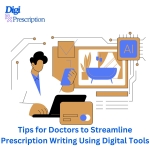
Tips for Doctors to Streamline Prescription Writing Using Digital Tools
In today’s fast-paced healthcare environment, digital tools are becoming indispensable for doctors. Prescription writing, traditionally a time-consuming task, can now be streamlined and optimized with digital prescription software. Not only does this save time, but it also improves accuracy and enhances patient safety. Below are actionable tips for doctors to streamline their prescription writing process using digital tools.
1. Choose the Right Digital Prescription Software
Selecting the right tool is the foundation of efficient prescription writing.
- Key Features to Look For:
Look for software with user-friendly interfaces, customizable templates, and integrated drug databases. - Cloud-Based Accessibility:
Opt for cloud-based systems so you can access patient data from anywhere. - Integration Options:
Ensure the software integrates with your clinic’s Electronic Health Record (EHR) system.
2. Set Up Pre-Built Templates
Using pre-built templates for common diagnoses and treatment plans saves time.
- Diagnosis-Specific Templates:
Create templates for frequently treated conditions like hypertension, diabetes, or allergies. - Customizable Fields:
Choose software that allows customization to include dosage, frequency, and duration. - Quick Access Shortcuts:
Assign hotkeys or shortcuts to frequently used templates for faster access.
3. Utilize Drug Databases for Accurate Prescriptions
Integrated drug databases reduce errors and enhance prescribing accuracy.
- Drug Interaction Alerts:
Digital tools notify you about potential drug interactions or contraindications. - Dosage Recommendations:
Get automated dosage suggestions based on the patient’s age, weight, and condition. - Search Functionality:
Use search filters to quickly find medications by brand name or generic alternatives.
4. Embrace Voice Recognition Technology
Voice-to-text tools can make the prescription-writing process faster and hands-free.
- Real-Time Transcription:
Dictate prescriptions, and the software will convert them into written text instantly. - Error Reduction:
Advanced voice recognition reduces typographical errors, improving prescription clarity. - Integration with Devices:
Use compatible devices like smartphones or tablets for greater flexibility.
5. Automate Refill Requests
Digital tools simplify managing prescription refills, benefiting both doctors and patients.
- One-Click Refills:
Allow patients to request refills via an online portal, which you can approve with a single click. - Reminders:
Set reminders for follow-up appointments and prescription renewals to improve adherence. - Reduced Paperwork:
Save time by reducing manual refill documentation.
6. Leverage E-Prescriptions for Seamless Communication
E-prescription tools facilitate direct communication with pharmacies.
- Instant Transfers:
Send prescriptions directly to pharmacies, reducing patient wait times. - Medication History Access:
View patients’ past prescriptions to ensure continuity of care. - Cost Transparency:
Some tools provide cost estimates or suggest affordable medication alternatives.
7. Train Your Staff and Collaborate
Efficient use of digital tools requires team collaboration and proper training.
- Training Sessions:
Conduct regular training sessions for your staff to use the software effectively. - Delegate Tasks:
Allow support staff to handle routine tasks like data entry and template creation. - Feedback Loop:
Regularly collect feedback from staff and patients to improve processes.
8. Maintain Data Security and Compliance
Digital tools must comply with data security and privacy regulations.
- Encryption and Access Control:
Use software with end-to-end encryption and role-based access. - HIPAA/Local Compliance:
Ensure the software adheres to medical data protection laws in your region. - Regular Updates:
Keep your software updated to safeguard against potential security vulnerabilities.
9. Use Analytics for Continuous Improvement
Data insights from digital tools can help optimize your prescription-writing workflow.
- Track Time Spent:
Use analytics to identify bottlenecks and streamline time-consuming steps. - Identify Trends:
Analyze data to see patterns in prescriptions, helping you improve treatment strategies. - Set Goals:
Use data to establish efficiency benchmarks for your practice.
10. Take Advantage of Mobile Compatibility
Mobile-friendly digital tools enable on-the-go prescription writing.
- Cross-Device Syncing:
Ensure prescriptions sync across devices, including desktops, tablets, and smartphones. - Mobile Apps:
Use dedicated apps for fast and efficient prescription management during hospital rounds. - Offline Mode:
Choose software with offline functionality to work without internet access.
Conclusion
Digital prescription tools are transforming healthcare by simplifying workflows, reducing errors, and improving patient care. By adopting the right software, leveraging its features, and ensuring proper training, doctors can streamline prescription writing and focus more on patient care. Embracing these technologies is a vital step toward modernizing medical practices and staying ahead in today’s competitive healthcare environment.
